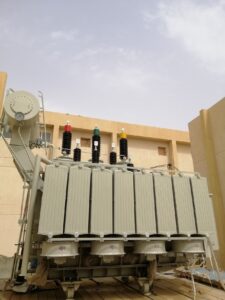Electric transformers play a crucial role in power distribution systems by transforming voltage levels for efficient transmission and delivery of electricity.
However, voltage regulation is vital to ensure optimal performance and reliability of transformers.
Voltage drop, a phenomenon caused by various factors, can significantly impact the operation of electric transformers. Voltage drop has a detrimental effect on electric transformers, leading to decreased efficiency, increased heating and losses, reduced voltage regulation, and a shorter lifespan.
In this article, we will explore the effects of voltage drop on transformers and discuss strategies to mitigate its consequences.
Table of Contents
Voltage Drop: Definition and Causes
Voltage drop refers to the reduction in voltage that occurs as electricity flows through conductors and components.
Several factors contribute to voltage drop, including resistance in transformer windings, line impedance, and load characteristics.
Transformers are susceptible to voltage drop due to the inherent resistance of their windings and the impedance of the transmission lines.
Effects of Voltage Drop on Electric Transformers
Voltage drop can have several detrimental effects on electric transformers. First, it decreases the overall efficiency of the transformer, leading to increased energy losses and decreased performance.
The energy losses manifest as heat, which can further exacerbate the impact of voltage drop. Additionally, voltage drop reduces the transformer’s ability to regulate voltage accurately, resulting in voltage fluctuations and poor power quality.
Over time, the continuous exposure to voltage drop can also shorten the lifespan of the transformer, leading to frequent maintenance and replacement costs.
Consequences of Voltage Drop on Power Distribution Systems
Voltage drop not only affects transformers but also has significant consequences for power distribution systems.
When voltage drop occurs, the voltage delivered to the load end is reduced, which can result in insufficient power supply and compromised performance of electrical devices.
Moreover, voltage drop can lead to power quality issues such as voltage sags, flickering lights, and equipment malfunctions.
These disruptions can disrupt normal operations and affect productivity in industrial settings.
Mitigating Voltage Drop in Electric Transformers

To mitigate the effects of voltage drop on electric transformers, several strategies can be employed.
First and foremost, proper transformer sizing is crucial to ensure that the transformer can handle the anticipated load without excessive voltage drop.
Minimizing line impedance through the use of larger conductors and reducing cable lengths can also help alleviate voltage drop.
Furthermore, employing voltage regulation techniques such as tap changers or automatic voltage regulators can help maintain stable voltage levels.
Load management strategies, such as load balancing and optimizing power factor, can also mitigate voltage drop effects.
Read my comprehensive article: The Wire Size Dilemma: How It Impacts Voltage Drop.
Case Studies and Examples
Real-world instances have demonstrated the impact of voltage drop on electric transformers. In one case, a distribution transformer located far from the load experienced significant voltage drop, resulting in decreased efficiency and increased losses.
To address this issue, the utility company installed a voltage regulator at the transformer and improved line conductor sizes, effectively reducing voltage drop and enhancing performance.
Future Developments and Research
Continued advancements in transformer design are aimed at minimizing the effects of voltage drop.
Researchers are exploring innovative materials and construction techniques to reduce resistance in transformer windings, thus reducing voltage drop.
Additionally, smart grid technologies are being developed to improve voltage regulation and enhance the overall efficiency of power distribution systems.
Conclusion
Voltage drop poses a significant challenge for electric transformers, impacting their efficiency, voltage regulation, and overall lifespan.
By understanding the causes and consequences of voltage drop, and implementing appropriate mitigation strategies, the detrimental effects can be minimized.
Proper transformer sizing, reducing line impedance, utilizing voltage regulation techniques, and implementing load management strategies are essential steps towards ensuring optimal performance and reliability in power distribution systems.
Continued research and advancements in transformer design and smart grid technologies will contribute to further mitigating the effects of voltage drop, ensuring efficient and reliable electricity supply for various applications.
Don’t Leave Empty-Handed!
Install my Free Android App on Google Play:
Electrical Cables Most Common Tables “Cables Tables”
And, my Electrical Calculations App “Fast Electrical Calculator”
Discover more great content by subscribing to My channel
Looking to stay ahead of the game in the world of electrical engineering? Subscribe to my YouTube channel and gain access to exclusive content you won’t find anywhere else!
The staff I recommend
(Amazon Affiliate Links to products I believe are high quality):
- Economy 120 Volt/60Hz AC Power Source – Step-Down Voltage & Frequency Converters 1800W
- UNI-T Digital Multimeter Tester UT139C
- 50-Amp Extension Cord for RV “100ft”
- Voltage Stabilizer 110/220v
- Hair Dryer “best selling“
- TOSHIBA EM131A5C-BS Countertop Microwave Ovens
Disclaimer: This contains affiliate links to Amazon products. I may earn a commission for purchases made through these links.


